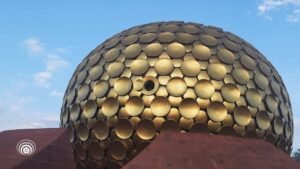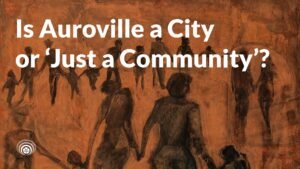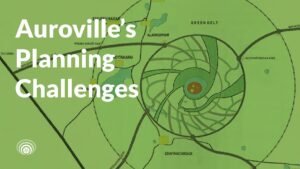Sri Aurobindo began his Yoga in 1904. Even before this he had already some spiritual experiences and that before he knew anything about Yoga or even what Yoga was. For example, a vast calm descended upon him at the moment when he stepped first on Indian soil after his long absence, in fact with his first step on the Apollo Bunder in Bombay. This calm surrounded him and remained for long months afterwards. There was also a realisation of the vacant Infinite while walking on the ridge of the Takhte-Suleman in Kashmir, the living Presence of Kali in a shrine on the banks of the Narmada, the vision of the Godhead surging up from within when in danger of a carriage accident in Baroda in the first year of his stay, etc. But these were inner experiences coming of themselves and with a sudden unexpectedness, not part of a sadhana. He started Yoga by himself without a Guru, getting the rule from a friend, a disciple of Brahmananda of Ganga Mutt; it was confined at first to assiduous practice of Pranayam (at one time for six or more hours a day). There was no conflict or wavering between Yoga and politics; when he started Yoga, he carried on both without any idea of opposition between them.
He wanted however to find a Guru. He met a Naga Sannyasi, one of the heads, in the course of this search, but did not accept him as Guru, but was confirmed by him in a belief in Yoga-power when he saw him cure Barin in almost a moment of a violent and clinging hill fever by merely cutting through a glassful of water crosswise with a knife while he repeated a silent mantra. Barin drank and was cured. Sri Aurobindo also met Brahmananda and was greatly impressed by him; but he had no helper or Guru in Yoga till he met Lele in Baroda and that was only for a short time. Meditating only for three days with Lele, he followed his instructions for silencing the mind and freeing it from the constant pressure of thoughts; he entered into an absolute and complete silence of the mind
and indeed of the whole consciousness and in that silence had suddenly the enduring realisation of the indefinable Brahman, Tat, in which the whole universe seemed to be unreal and only That existed. This silence he kept for several months and it remained always within him; for when activity returned, it proceeded on the surface and within him all was calm. But at the time there was not the slightest activity of any kind even on the surface; there was only a still motionless perception spiritual and mental in its character. But this was not what Lele wanted, for he wanted the silence only in order that the inner voice of the heart might be heard without any thought interference; so he did his best to get him out of this Advaitic condition. A meeting was to be held in Bombay to hear Sri Aurobindo speak and he asked Lele how he was to speak when not even the shadow of a passing thought could arise in him. Lele told him to make Namaskar before delivering a speech to the audience and wait and speech would come to him from another source than the mind. So in fact, when he was about to address the meeting, speech came. It should be noted however that Sri Aurobindo was not at any time in trance and something in him saw all that happened and spoke and acted according to need without the necessity of any conceptual thought or personal volition. Ever since all the mental activities, speech, writing, thought, will and other kindred activities came to him from the same source above the brain-mind; he had entered into the spiritual mind and what he afterwards called the overhead consciousness. This was his first major and fundamental Yogic realisation and experience and the true beginning and foundation of his Yoga.
Sri Aurobindo himself once wrote in a letter about his practice of Yoga: “I began my Yoga in 1904 without a Guru; in 1908 I received important help from a Mahratta yogi and discovered the foundations of my sadhana; but from that time till the Mother came to India I received no spiritual help from anyone else. My sadhana before and afterwards was not founded upon books but upon personal experiences that crowded on me from within. But in the jail I had the Gita
and the Upanishads with me, practised the Yoga of the Gita and meditated with the help of the Upanishads, these were the only books from which I found guidance; the Veda which I first began to read long afterwards in Pondicherry rather confirmed what experiences I already had than was any guide to my sadhana. I sometimes turned to the Gita for light when there was a question or a difficulty and usually received help or an answer from it. It is a fact that I was hearing constantly the voice of Vivekananda speaking to me for a fortnight in the jail in my solitary meditation and felt his presence. The voice spoke only on a special and limited but very important field of spiritual experience and it ceased as soon as it had finished saying all that it had to say on that subject.”
Before coming to Pondicherry Sri Aurobindo had already realised in full two of the four great realisations on which his Yoga and his spiritual philosophy are founded. The first he had gained while meditating with the Maharashtrian Yogi, Vishnu Bhaskar Lele at Baroda in January 1908; it was the realisation of the silent spaceless and timeless Brahman gained after a complete and abiding stillness of the whole consciousness and attended at first by the overwhelming feeling and percepfion of the total unreality of the world, though this feeling disappeared after his second realisation which was that of the cosmic consciousness and of the Divine as all beings and all that is, which happened in the Alipore Jail. To the other two realisations, that of the supreme Reality with the static and dynamic Brahman as its two aspects and that of the higher planes of consciousness leading up to the Supermind, he was already on his way in his meditations in Alipore Jail. Moreover, he had accepted from Lele as the principle of his sadhana to rely wholly on the Divine and his guidance alone both for his sadhana and his outward actions.
Thus gathering the essential elements of spiritual experience that are gained by the path of divine communion and spiritual realisation followed till now in India, he passed on in his Pondicherry life in search of a more complete experience uniting and harmonising the two ends of existence, Spirit and Matter. Most ways of Yoga are paths to the Beyond leading to the Spirit and in the end, away from life; Sri Aurobindo’s rises to the Spirit to redescend with its gains, bringing the light and power and bliss of the Spirit into life to transform it. Man’s present existence in the material world is in this view or vision of things a life in the Ignorance with the Inconscient at its base, but even in its darkness and nescience there are involved the presence and possibilities of the Divine. The created world is not a mistake or a vanity and illusion to be cast aside by the soul returning to heaven or Nirvana, but the scene of a spiritual evolution by which out of this material inconscience is to be manifested progressively the Divine Consciousness in things. Mind is the highest term yet reached in the evolution, but it is not the highest of which it is capable. There is above it a Supermind or eternal Truth-Consciousness which is in its nature the self-aware and self-determining light and power of Divine Knowledge. Mind is an ignorance seeking after Truth, but this is a self-existent Knowledge harmoniously manifesting the play of its forms and forces. It is only by the descent of this Supermind that the perfection dreamed of by all that is highest in humanity can
come. It is possible by opening to a greater divine consciousness to rise to this power of light and bliss, discover one’s true self, remain in constant union with the Divine and bring down the supramental Force for the transformation of mind and life and body. To realise this possibility has been the dynamic aim of Sri Aurobindo’s Yoga.
During all his stay at Pondicherry from 1910 he remained more and more exclusively devoted to his spiritual work and his sadhana. On 15 August 1914, he started jointly with the Mother the philosophical monthly Arya through which he revealed the findings of his four years of seeking — new messages for humanity: man’s divine destiny, the path to its realisation, the progress of human society towards its divine future, the unification of the human race, the nature and evolution of poetry and its future, the inner meaning of the Veda, the Upanishads and the Gita, the spirit and significance of Indian civilisation and culture. All these have since been embodied in The Life Divine, The Synthesis of Yoga, The Human Cycle, The Ideal of Human Unity, The Future Poetry, On the Veda, The Upanishads, Essays on the Gita, The Foundations of Indian Culture. The Arya ceased publication in 1921 after six and a half years of uninterrupted appearance. Sri Aurobindo’s supreme work in poetry is the epic Savitri in 23,813 lines of blank verse, the longest poem ever written in English, regarded by an American critic as ‘probably the greatest epic in the English language… a perfect cosmic poem’. Besides Savitri, there is a large body of his poetic creation, including several dramas, all of which have since been in book form. Sri Aurobindo lived at first in retirement at Pondicherry with four or five companions. Afterwards more and yet more began to come to him to follow his spiritual path and the number became so large that a community of sadhaks had to be formed for the maintenance and collective guidance of those who had left everything behind for the sake of a higher life. This was the foundation of the Sri Aurobindo Ashram which has less been created than grown around him and the Mother as its centre. It may be pointed out in this connection that Sannyas was never accepted by Sri Aurobindo as part of his Yoga. His Ashram at Pondicherry is a glaring contradiction to this popular idea of Sannyas connected with the name of an Ashram. Members of his Ashram are not Sannyasis, they do not wear the ochre garb or practice complete asceticism but are sadhaks of a life based on spiritual realisation, the ideal being the attainment of the life divine here on this earth and in the earthly existence.
Kittu Reddy




